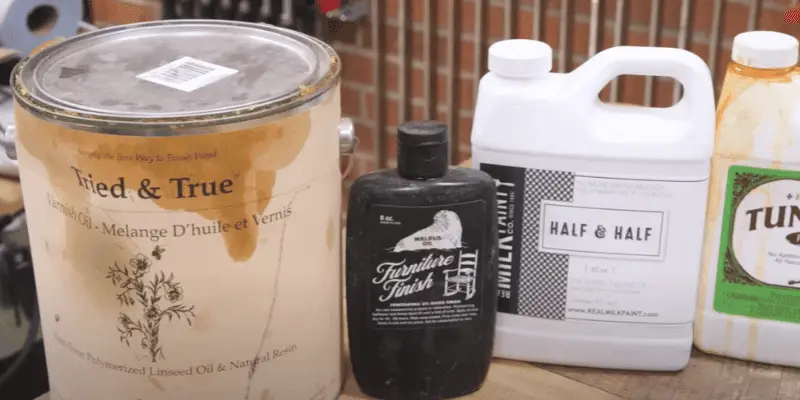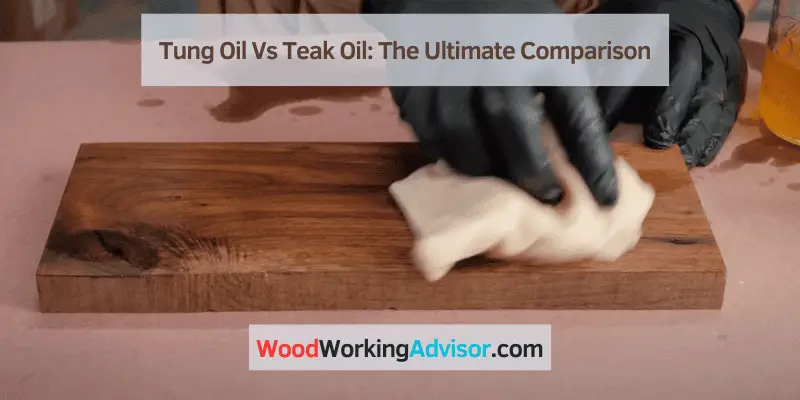Tung oil and teak oil are both popular wood finishing options, but they differ in their origins and use. Tung oil is a natural, non-toxic oil obtained from the seeds of the tung tree and is best for enhancing the natural beauty of wood.
Teak oil, on the other hand, is a blend of oils and resins designed specifically for teak wood and outdoor use. As you consider which oil to use for your wood finishing project, it’s important to understand the unique qualities of each.
We’ll explore the characteristics, pros, and cons of Tung oil and teak oil to help you make an informed decision. Whether you’re a DIY enthusiast or a professional woodworker, the right oil can make a significant difference in the appearance and longevity of your wood projects.
Tung Oil Vs Teak Oil: Understanding The Basics
When it comes to preserving and enhancing the natural beauty of wood, Tung oil and Teak oil are two popular choices. Understanding the basics of these oils can help you make an informed decision when it comes to protecting your wood surfaces. Below, we’ll take a closer look at the differences between Tung oil and Teak oil to help you understand their unique properties and uses.
What Is Tung Oil?
Tung oil, also known as China wood oil, is derived from the nuts of the Tung tree. It has been used for centuries as a wood finish and preservative due to its durability and water-resistant properties. Tung oil penetrates deeply into the wood, providing a natural, low-sheen finish that highlights the wood grain while protecting it from moisture and mildew.
What Is Teak Oil?
Teak oil is a combination of various natural oils that is specifically formulated for use on teak and other hardwoods. It is designed to penetrate the wood, providing a protective, moisture-resistant finish while enhancing the natural color and grain of the wood. Teak oil is commonly used on outdoor furniture and other wood surfaces exposed to the elements.
Tung Oil: Properties And Applications
Tung oil, also known as China wood oil, is a natural oil derived from the seeds of the tung tree. It has been utilized for centuries in various applications, particularly in woodworking and finishing due to its exceptional properties. Let’s delve deeper into the natural origin, composition, and uses of tung oil.
Natural Origin And Composition
Tung oil is obtained from the seeds of the tung tree (Aleurites fordii) and the related Aleurites montana, commonly found in East Asia. The oil is extracted through a process of pressing and solvent extraction, resulting in a pale yellow to dark amber oil with a nutty aroma. Tung oil is composed of triglycerides and contains a high percentage of alpha-eleostearic acid, which contributes to its exceptional drying properties.
Uses In Woodworking And Finishing
Tung oil is highly valued for its versatility in woodworking and finishing applications. It is frequently used as a wood finish to enhance the natural beauty of the wood while providing a durable and water-resistant surface. The unique drying characteristics of tung oil make it an ideal choice for finishing wooden furniture, flooring, and cabinetry. Additionally, it is often combined with other oils or resins to create bespoke finishing blends tailored to specific project requirements.
Teak Oil: Characteristics And Uses
Teak oil is a popular choice for finishing outdoor furniture due to its natural UV protection and water resistance. Tung oil, on the other hand, is derived from the nut of the tung tree and offers a more durable finish, making it ideal for heavy-duty furniture and flooring.
Both oils provide a rich, warm appearance, enhancing the natural beauty of the wood.
Derived from Teak Tree Seeds
Derived from the seeds of the teak tree, teak oil is known for its distinctive properties and wide range of applications. The oil is extracted through a process of pressing teak seeds, which yields a rich, amber-colored oil. Due to its natural origin, teak oil is an eco-friendly option for wood finishing, making it a popular choice among environmentally conscious consumers. The unique composition of teak oil provides both protective and aesthetic benefits, making it a versatile solution for enhancing the look and durability of wooden surfaces.
Common Applications and Benefits
Teak oil is commonly used for treating and preserving various wooden surfaces, including furniture, decks, and outdoor structures. Its protective properties help to resist moisture, prevent warping, and guard against damage from UV rays, which is particularly beneficial for outdoor applications. In addition to its protective benefits, teak oil also enhances the natural beauty of wood, bringing out the richness of its color and grain. This makes it a favored choice for those seeking to maintain the authentic appearance of wooden items while providing ongoing protection against wear and tear.
When applied to furniture, the oil penetrates the surface, bringing out the inherent warmth and character of the wood. This process creates a lustrous finish that highlights the natural beauty of the grain while offering long-lasting protection against environmental elements. For outdoor wooden structures, such as teak garden furniture and patio decks, teak oil provides a durable, weather-resistant coating that helps to maintain the integrity of the wood and extend its lifespan.
In summary, teak oil offers a combination of protective and aesthetic benefits, making it an ideal choice for preserving and enhancing the natural beauty of wood in a variety of settings. Its origins in the teak tree seeds, coupled with its environmentally friendly profile, contribute to its widespread appeal as a sustainable wood finishing solution.
Tung Oil Vs Teak Oil: A Detailed Comparison
Choosing the right wood finish can be a crucial decision when it comes to preserving the natural beauty and longevity of your wooden surfaces. Tung oil and teak oil are popular choices for protecting and enhancing wood, but they have distinct differences in terms of durability, protection against moisture and UV rays, as well as maintenance and application considerations. In this detailed comparison, we’ll delve into the key factors to consider when deciding between tung oil and teak oil for your woodworking projects.
Durability And Longevity
Tung oil, derived from the nut of the tung tree, is renowned for its exceptional durability and longevity. When applied correctly, tung oil can penetrate deep into the wood, providing a strong and lasting protective layer. On the other hand, teak oil is a blend of oil and solvents, often used for outdoor furniture made of teak wood. While it offers decent protection, it may not match the long-term durability of pure tung oil.
Protection Against Moisture And UV rays
Both tung oil and teak oil provide protection against moisture and UV rays. Tung oil creates a water-resistant barrier that helps shield the wood from moisture, while also offering some UV protection. Teak oil, while effective at repelling moisture, may require more frequent applications to maintain its protective properties, especially in outdoor settings with prolonged exposure to sunlight.
Maintenance And Application Considerations
Tung oil typically requires fewer maintenance efforts compared to teak oil. Once applied, tung oil forms a hard, protective finish that can last for years, reducing the need for frequent reapplication. On the other hand, teak oil may need more regular reapplications, especially for outdoor furniture exposed to the elements. Additionally, the application process for tung oil involves coating the wood with thin layers and allowing sufficient drying time between coats, while teak oil can be applied more liberally, but also needs time to dry thoroughly.

Tung Oil Vs Teak Oil: Environmental Impact
When considering the environmental impact of Tung Oil and Teak Oil, it is important to evaluate sustainability and eco-friendliness, as well as their impact on indoor air quality.
Sustainability And Eco-friendliness
Sustainability is a crucial aspect to consider when choosing between Tung Oil and Teak Oil. Tung Oil is derived from the seeds of the Tung tree, which is a sustainable and renewable resource. The Tung tree is known for its rapid growth and minimal environmental impact, making Tung Oil an eco-friendly choice for environmentally conscious consumers.
On the other hand, while teak trees are also considered renewable, their rate of growth is significantly slower than Tung trees. This can impact the sustainability of Teak Oil, as it may take longer to replenish the teak tree population. Additionally, the harvesting and processing of teak trees can have a more significant environmental footprint compared to Tung Oil production.
Impact On Indoor Air Quality
Tung Oil is a natural, low-VOC (volatile organic compound) product, which means it has minimal negative impact on indoor air quality. It releases fewer harmful chemicals into the air, making it a healthier choice for indoor use. The VOCs in Tung Oil evaporate quickly, reducing the risk of indoor air pollution and supporting a safer living environment.
In contrast, while Teak Oil is also known for its low VOC content, some formulas may contain added solvents or drying agents that could potentially impact indoor air quality. It is important to carefully select a Teak Oil product that is specifically designed to minimize its impact on indoor air quality.
Tung Oil Vs Teak Oil: Making The Best Choice
When it comes to finishing wood projects, choosing between tung oil and teak oil can be a perplexing decision. Each oil comes with its unique characteristics and it’s essential to assess them according to specific project requirements. Let’s delve into the distinct features of these two oils to aid in making an informed choice for your next woodworking endeavor.
Factors To Consider For Specific Projects
When selecting between tung oil and teak oil, certain essential factors need to be taken into account to ensure the best outcome for your project.
Recommendations Based On Use Case And Desired Finish
Depending on the use case of the wood project and the desired finish, the selection between tung oil and teak oil can vary. It’s crucial to understand the specific recommendations to ensure the best results for your woodworking project.
Frequently Asked Questions On Tung Oil Vs Teak Oil
What Are The Main Differences Between Tung Oil And Teak Oil?
Tung oil is a natural oil that provides a hard-wearing finish, while teak oil is specifically designed for outdoor teak furniture. Tung oil penetrates the wood to create a durable, waterproof finish, whereas teak oil offers UV protection. Both provide different levels of protection and aesthetics.
How Do I Know When To Use Tung Oil Or Teak Oil?
Deciding between Tung oil and teak oil depends on the type of wood and the desired finish. Tung oil is ideal for dense woods to enhance the natural beauty and provide waterproofing, while teak oil is suitable for outdoor teak furniture to protect against weathering and UV rays.
Understanding the wood characteristics is crucial in making the right choice.
Can Tung Oil And Teak Oil Be Used Interchangeably?
Tung oil and teak oil serve different purposes and are not interchangeable. Tung oil provides a durable, water-resistant finish and is commonly used on interior wooden surfaces, while teak oil is tailored for outdoor teak furniture to protect against sun exposure and moisture.
Using the appropriate oil for the intended application ensures optimal results.
What Is The Application Process For Tung Oil And Teak Oil?
When applying Tung oil, ensure the surface is clean and free of any previous finishes or debris. Apply thin, even coats, allowing sufficient drying time between applications. Teak oil should be applied in the direction of the wood grain, with excess wiped off after a few minutes.
Multiple coats may be necessary for desired protection and sheen.
Conclusion
In the end, choosing between tung oil and teak oil comes down to understanding their differences. Consider the wood type, finish preference, and maintenance level needed. Both oils offer protective and enhancing qualities, so make the choice based on your specific needs and desired results.
Selecting the right oil will ensure a beautiful and long-lasting wood finish.



2 thoughts on “Tung Oil Vs Teak Oil: The Ultimate Comparison”